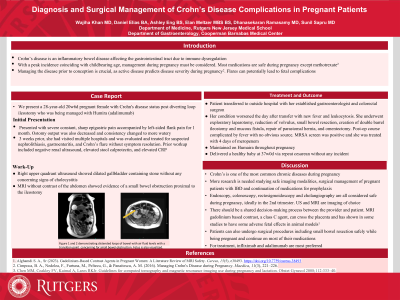Tuesday Poster Session
Category: IBD
P4421 - Diagnosis and Surgical Management of Crohn’s Disease Complications in Pregnant Patients
Tuesday, October 29, 2024
10:30 AM - 4:00 PM ET
Location: Exhibit Hall E

Has Audio

Wajiha Khan, MD
Rutgers New Jersey Medical School
Cartaret, NJ
Presenting Author(s)
Wajiha Khan, MD1, Daniel Elias, BA2, Ashley Eng, BS2, Elan Meltzer, MBS2, Ritik M. Goyal, MBBS2, Dhanasekaran Ramasamy, MD3, Shiva Kumar, MD4, Sunil Sapru, MD5
1Rutgers New Jersey Medical School, Cartaret, NJ; 2Rutgers New Jersey Medical School, Newark, NJ; 3Cooperman Barnabas Medical Center, Livingston, NJ; 4Cleveland Clinic, Abu Dhabi, Abu Dhabi, United Arab Emirates; 5RWJ Barnabas Health, Livingston, NJ
Introduction: Crohn's disease (CD) is an inflammatory bowel disease (IBD) of multifactorial etiology, characterized by chronic remitting, relapsing inflammation of the gastrointestinal tract. CD is often complicated by malabsorption, anemia, bowel stricture, and abscesses. Pharmacotherapeutic options include corticosteroids, biologics, immunomodulators, and 5-aminosalicylic acid derivatives. Peak incidence of the disease coincides with childbearing age, necessitating careful consideration of nuances specific to pregnancy and lactation. Most of the commonly used medications in CD have been shown to be safe during pregnancy except methotrexate. Minimizing disease flares prior to conception and maintaining remission throughout pregnancy are important considerations, since disease flares could result in fetal complications.
Case Description/Methods: A 28-year-old female with CD complicated by diverting loop ileostomy, on maintenance therapy with adalimumab presented to the hospital at 21 weeks gestation with a one-month history of severe constant, sharp epigastric pain accompanied by left-sided flank pain. She had previously visited multiple hospitals and received treatment for nephrolithiasis, gastroenteritis, and presumed flare of CD, without symptom resolution. She also described decreased ostomy output and watery stools. Right upper quadrant ultrasound was unremarkable.
Persistent symptoms with diagnostic uncertainty mandated cross-sectional imaging, with careful consideration of nuances related to the patient’s gravid status. MRI without contrast revealed small bowel obstruction (SBO), warranting transfer of the patient to a higher level of care, where she promptly underwent exploratory laparotomy, which revealed obstruction at the ostomy site. She had resolution of symptoms and was able to resume her maintenance regimen with adalimumab. Subsequent clinical course was characterized by recurrent SBO due to adhesions at 33 weeks gestation, necessitating surgical adhesiolysis, followed by delivery of a healthy baby at 37 weeks gestation.
Discussion: There is paucity of data to guide choice of optimal imaging modality, endoscopic evaluation, and surgical management of pregnant patients with IBD. With the advent of several new approved biologic agents and biosimilars, further study is also warranted to evaluate safety and efficacy of these medications in this setting. Given the predominant age group affected, establishment of robust pregnancy registries remains an unmet need in IBD.

Disclosures:
Wajiha Khan, MD1, Daniel Elias, BA2, Ashley Eng, BS2, Elan Meltzer, MBS2, Ritik M. Goyal, MBBS2, Dhanasekaran Ramasamy, MD3, Shiva Kumar, MD4, Sunil Sapru, MD5. P4421 - Diagnosis and Surgical Management of Crohn’s Disease Complications in Pregnant Patients, ACG 2024 Annual Scientific Meeting Abstracts. Philadelphia, PA: American College of Gastroenterology.
1Rutgers New Jersey Medical School, Cartaret, NJ; 2Rutgers New Jersey Medical School, Newark, NJ; 3Cooperman Barnabas Medical Center, Livingston, NJ; 4Cleveland Clinic, Abu Dhabi, Abu Dhabi, United Arab Emirates; 5RWJ Barnabas Health, Livingston, NJ
Introduction: Crohn's disease (CD) is an inflammatory bowel disease (IBD) of multifactorial etiology, characterized by chronic remitting, relapsing inflammation of the gastrointestinal tract. CD is often complicated by malabsorption, anemia, bowel stricture, and abscesses. Pharmacotherapeutic options include corticosteroids, biologics, immunomodulators, and 5-aminosalicylic acid derivatives. Peak incidence of the disease coincides with childbearing age, necessitating careful consideration of nuances specific to pregnancy and lactation. Most of the commonly used medications in CD have been shown to be safe during pregnancy except methotrexate. Minimizing disease flares prior to conception and maintaining remission throughout pregnancy are important considerations, since disease flares could result in fetal complications.
Case Description/Methods: A 28-year-old female with CD complicated by diverting loop ileostomy, on maintenance therapy with adalimumab presented to the hospital at 21 weeks gestation with a one-month history of severe constant, sharp epigastric pain accompanied by left-sided flank pain. She had previously visited multiple hospitals and received treatment for nephrolithiasis, gastroenteritis, and presumed flare of CD, without symptom resolution. She also described decreased ostomy output and watery stools. Right upper quadrant ultrasound was unremarkable.
Persistent symptoms with diagnostic uncertainty mandated cross-sectional imaging, with careful consideration of nuances related to the patient’s gravid status. MRI without contrast revealed small bowel obstruction (SBO), warranting transfer of the patient to a higher level of care, where she promptly underwent exploratory laparotomy, which revealed obstruction at the ostomy site. She had resolution of symptoms and was able to resume her maintenance regimen with adalimumab. Subsequent clinical course was characterized by recurrent SBO due to adhesions at 33 weeks gestation, necessitating surgical adhesiolysis, followed by delivery of a healthy baby at 37 weeks gestation.
Discussion: There is paucity of data to guide choice of optimal imaging modality, endoscopic evaluation, and surgical management of pregnant patients with IBD. With the advent of several new approved biologic agents and biosimilars, further study is also warranted to evaluate safety and efficacy of these medications in this setting. Given the predominant age group affected, establishment of robust pregnancy registries remains an unmet need in IBD.

Figure: Figure 1 demonstrates distended loops of bowel with air fluid levels and a transition point concerning for small bowel obstruction. A fetus is also visualized.
Disclosures:
Wajiha Khan indicated no relevant financial relationships.
Daniel Elias indicated no relevant financial relationships.
Ashley Eng indicated no relevant financial relationships.
Elan Meltzer indicated no relevant financial relationships.
Ritik Goyal indicated no relevant financial relationships.
Dhanasekaran Ramasamy indicated no relevant financial relationships.
Shiva Kumar indicated no relevant financial relationships.
Sunil Sapru indicated no relevant financial relationships.
Wajiha Khan, MD1, Daniel Elias, BA2, Ashley Eng, BS2, Elan Meltzer, MBS2, Ritik M. Goyal, MBBS2, Dhanasekaran Ramasamy, MD3, Shiva Kumar, MD4, Sunil Sapru, MD5. P4421 - Diagnosis and Surgical Management of Crohn’s Disease Complications in Pregnant Patients, ACG 2024 Annual Scientific Meeting Abstracts. Philadelphia, PA: American College of Gastroenterology.
